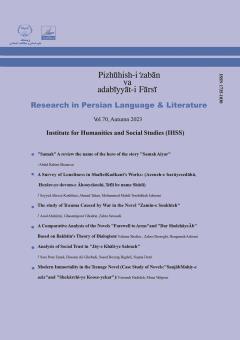Despite all the efforts made by the eloquent figures in the recognition of literary techniques, some of them are still unknown. This article introduces one of such technique known as "the artistic quotation" and elaborates the details in Hafez' poetry. What is an artis
More
Despite all the efforts made by the eloquent figures in the recognition of literary techniques, some of them are still unknown. This article introduces one of such technique known as "the artistic quotation" and elaborates the details in Hafez' poetry. What is an artistic quotation, how does its artistic aspect occur and what are its types? This article intends to respond to the mentioned questions.Our method is the descriptive method through the structuralism approach.The overall studies lead us to conclude that Hafez' artistic quotations have generally passed a balanced path both in narration and the poetic process; which is due to his tendency for moderation. And in these two-sided aspects considering the present situation, they have been united with several elements such as; the narrator, atmosphere, time and place setting, description, character, dialogue, incident, suspense, and the ornaments of the figures of speech like; metonymy, simile, style of finding the proper equivalent, metaphore, personification, paradox, irony, pun, phonemes, harmony of adjectives, equivocation, identification, convenance, contrast and many other figures of speech to be mentioned. Also examples of this technique cover a variety of divisions in his great poetry book depending on the basis of the definition in the details.
Manuscript profile


